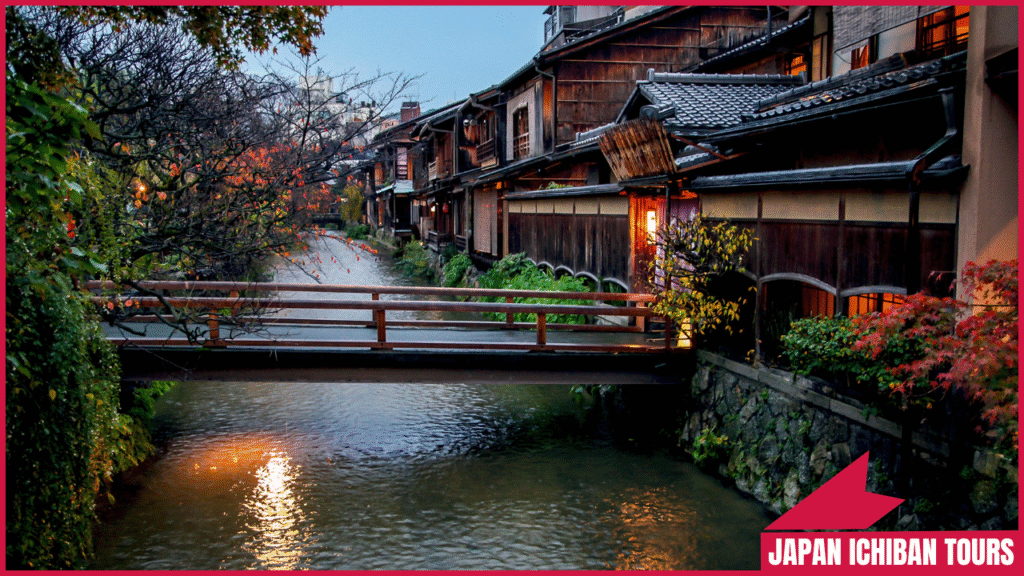
Kyoto, Japan’s cultural heart, blends ancient traditions with serene beauty, making it an unmissable destination in 2025. With over 2,000 temples and shrines, 17 UNESCO World Heritage sites, and vibrant seasonal events, Kyoto offers a rich tapestry of experiences for every traveler.
This guide highlights the must-see places in Kyoto, from iconic landmarks to hidden gems, with practical tips to plan your perfect adventure.
Whether you’re chasing cherry blossoms or autumn foliage, these attractions will captivate you in 2025. 5 Best Places to Visit in Kyoto: Top Attractions & Landmarks
Kyoto’s enduring charm lies in its 1,200-year history as Japan’s former capital, paired with modern accessibility like improved English signage and efficient public transit. In 2025, seasonal highlights—cherry blossoms (March–April) and vibrant foliage (October–November)—enhance its allure. From bustling markets to tranquil mountain temples, Kyoto caters to culture enthusiasts, foodies, and nature lovers alike.
Location: Southern Kyoto
Cost: Free
Why Visit: Fushimi Inari Taisha, dedicated to the Shinto god of prosperity, is renowned for its thousands of red torii gates winding up Mount Inari. This UNESCO-associated site offers a 2–3-hour hike through serene forests, with panoramic views at the summit. Its spiritual significance and photogenic trails make it Kyoto’s most iconic landmark.

Location: Northern Kyoto
Cost: ~$4
Why Visit: Kinkaku-ji, a Zen Buddhist temple and UNESCO World Heritage site, dazzles with its gold-leaf-covered upper floors reflecting in a tranquil pond. Surrounded by meticulously designed gardens, it’s a symbol of Kyoto’s elegance and spiritual depth, drawing visitors year-round.
Location: Western Kyoto
Cost: Free (Tenryu-ji Temple ~$5)
Why Visit: The Arashiyama Bamboo Grove is a breathtaking pathway of towering bamboo, offering a serene escape. Its ethereal beauty is perfect for photography and peaceful strolls. Nearby, Tenryu-ji Temple, a UNESCO site, and the Togetsukyo Bridge add cultural and scenic depth.
Location: Eastern Kyoto
Cost: ~$4
Why Visit: Kiyomizu-dera, a UNESCO World Heritage site, is perched on a hillside with a wooden stage offering sweeping views of Kyoto. Its sacred Otowa waterfall, where visitors drink for health, love, or success, adds spiritual allure. The nearby Sannen-zaka and Ninnen-zaka streets feature traditional shops and teahouses.
Location: Northern Kyoto
Cost: ~$2 (main hall), free for trails
Why Visit: Kurama-dera, a tranquil temple in the forested hills of northern Kyoto, offers a spiritual escape with fewer crowds than central landmarks. Reachable via a scenic hike or cable car (~$2), it’s known for its connection to tengu (mythical creatures) and stunning mountain views. The nearby Kurama Onsen (~$15) adds relaxation.
| Attraction | Location | Cost | Highlight | Best Time to Visit |
|---|---|---|---|---|
| Fushimi Inari | Southern Kyoto | Free | Torii gate hike | Sunrise (6–7 AM) |
| Kinkaku-ji | Northern Kyoto | $4 | Golden temple | Opening (9 AM) |
| Arashiyama | Western Kyoto | Free | Bamboo grove | Early morning (7–8 AM) |
| Kiyomizu-dera | Eastern Kyoto | $4 | Hilltop views | Late afternoon (4–6 PM) |
| Kurama-dera | Northern Kyoto | $2 | Mountain temple | Autumn mornings |

Immerse in Kyoto’s Zen heritage with a tea ceremony (~$20–$40) at venues like En Tea House in Gion. Learn to whisk matcha and savor wagashi sweets in a meditative setting.
Stroll Gion’s Hanami-koji Street to glimpse geiko or maiko (geisha apprentices). Attend a cultural show at Gion Corner (~$25) featuring tea ceremonies, koto music, and dance. Respect privacy and avoid unsolicited photos.
Kyoto’s 2025 festivals are cultural highlights. The Gion Matsuri (July) features massive yamaboko floats, while the Jidai Matsuri (October) showcases historic costumes (both free, food stalls ~$10–$20).
Kyoto’s buses and subways are efficient. Use a Kyoto City Bus & Subway Pass (~$10/day) for unlimited rides. IC cards (Suica/Pasmo, ~$20) work across transit and some shops.
Purchase an eSIM (Airalo, Ubigi, ~$10–$20 for 1–2 GB daily data) for navigation and translation. Download Google Translate and Maps.me for offline use.
Popular sites like Fushimi Inari and Arashiyama get busy. Visit early (7–9 AM) or late (4–6 PM) for quieter experiences. Kurama-dera and northern Kyoto offer crowd-free alternatives.
Kyoto’s grid layout is easy, but rural areas like Kurama may lack English signage. Use offline apps like Maps.me or carry a phrasebook. Koban (police boxes) near Kyoto Station offer help.
English signage is improving, but learn basic phrases like “Konnichiwa” (hello) or “Arigatou” (thank you). Google Translate’s camera feature helps with signs and menus.
Japan’s lost-and-found system is highly efficient. Report lost items at Kyoto Station or koban (free, ~$5–$10 for mailed items).

Kyoto’s must-see places in 2025—Fushimi Inari Taisha, Kinkaku-ji, Arashiyama Bamboo Grove, Kiyomizu-dera, and Kurama-dera—offer a perfect blend of cultural heritage, natural beauty, and spiritual depth. Enhance your visit with tea ceremonies, Gion strolls, or vibrant festivals. With efficient transit, budget-friendly hacks, and these insider tips, your Kyoto adventure will be a cultural journey to treasure.
What are Kyoto’s must-see attractions in 2025?
Fushimi Inari’s torii gates, Kinkaku-ji’s golden pavilion, Arashiyama’s bamboo grove, Kiyomizu-dera’s hillside views, and Kurama-dera’s mountain serenity are unmissable.
How can I avoid crowds at Kyoto’s landmarks?
Visit early (7–9 AM) or late (4–6 PM), especially at Fushimi Inari or Arashiyama. Explore Kurama-dera for a quieter experience.
What’s the best way to get around Kyoto?
Use a Kyoto City Bus & Subway Pass (~$10/day) or rent a bike (~$10/day) for flexibility, especially in Arashiyama or northern Kyoto.
How can I experience Kyoto’s culture?
Join a tea ceremony (~$20–$40), attend Gion Matsuri (free), or explore Gion’s geisha district for authentic cultural moments.
When’s the best time to visit Kyoto?
Spring (March–April) for cherry blossoms and autumn (October–November) for foliage offer ideal weather and stunning scenery.

Discover Japan Like Never Before 🇯🇵








Copyright © 2025 Japan Ichiban Tours | made with ❤️ by ideavire.com
Please select a template first

1 Comment
Must Do in Tokyo: Top Experiences You Can’t Miss in 2025 · August 26, 2025 at 8:20 pm
[…] With insider tips and practical advice, dive into Tokyo’s dynamic heart. Must-See Places in Kyoto for Travelers in 2025 […]